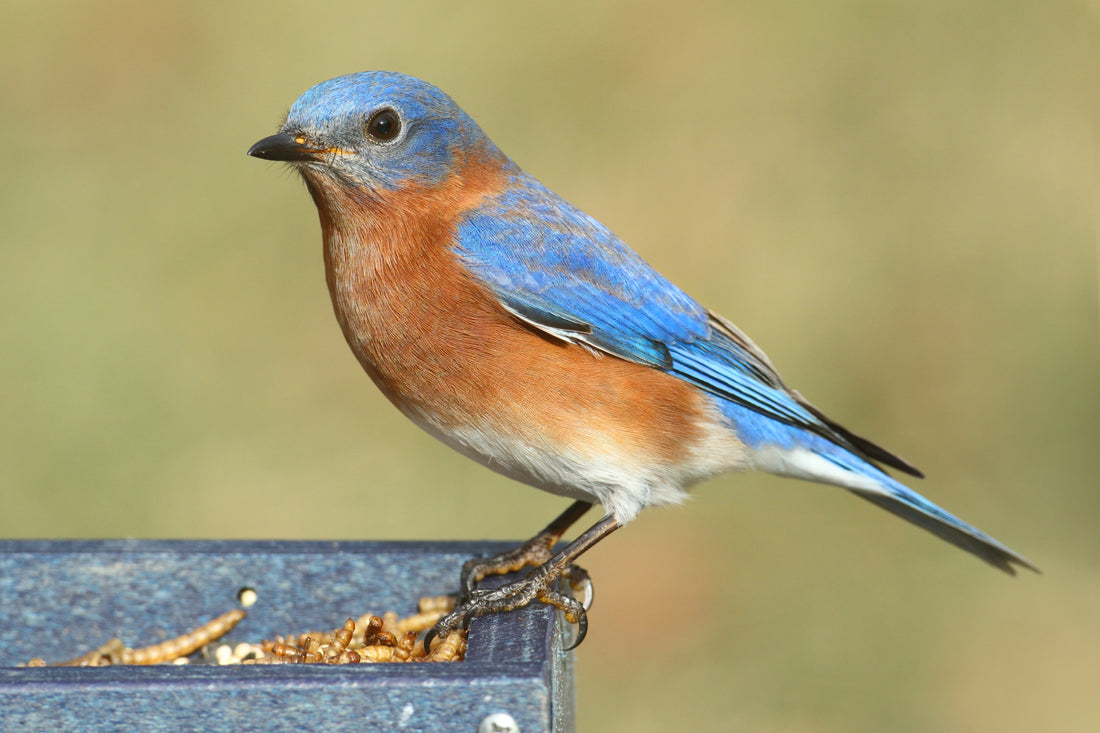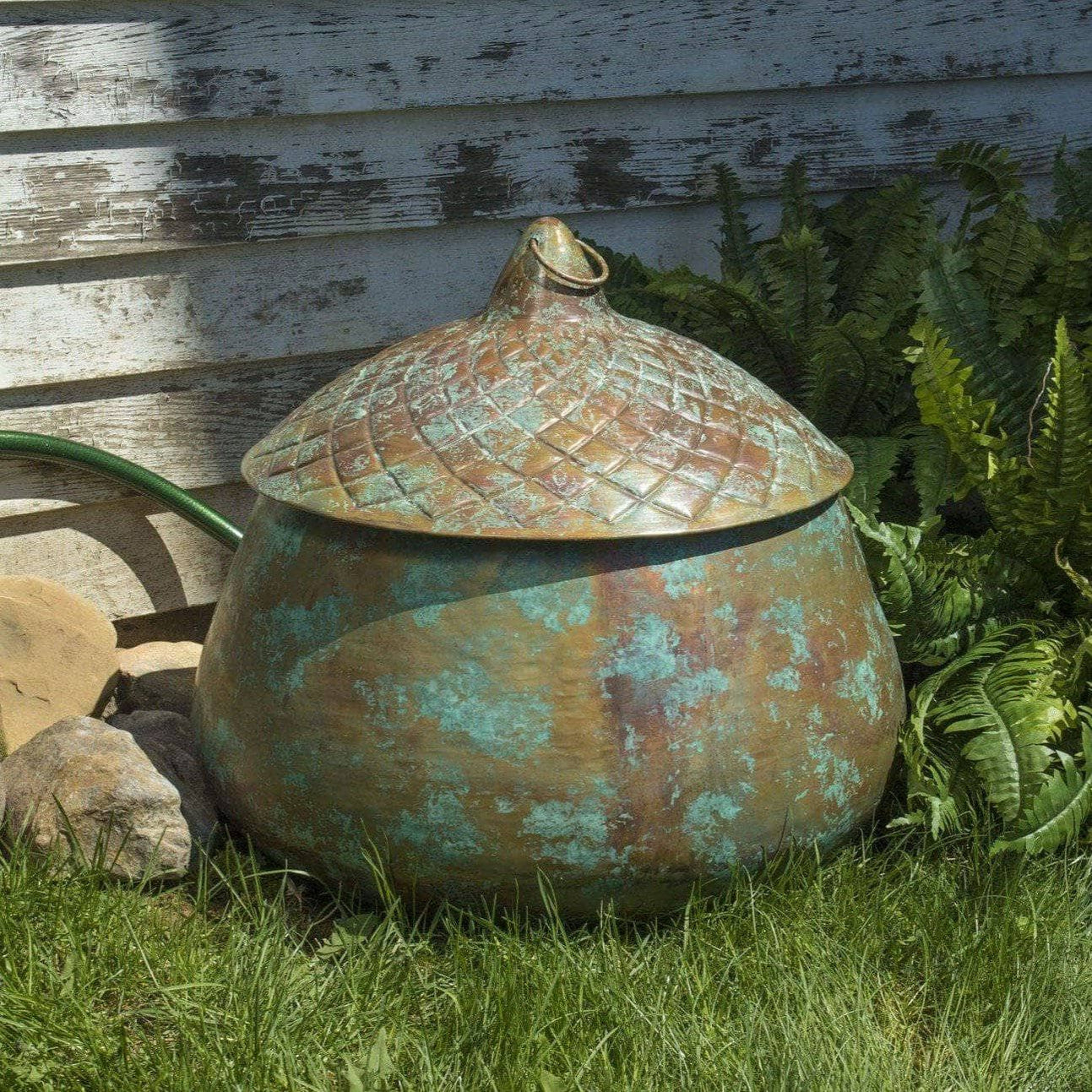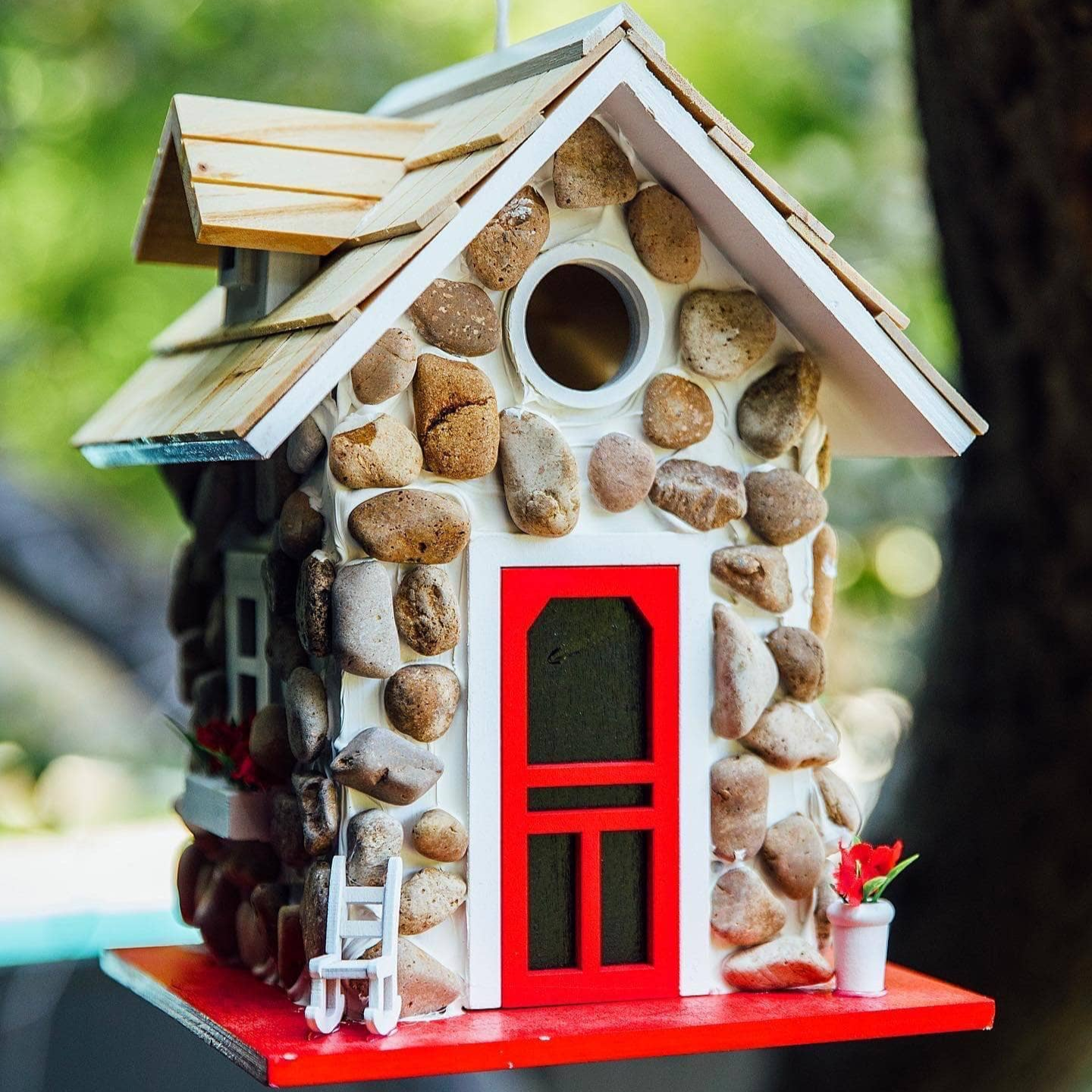
DIY Mealworm Feeder To Attract Bluebirds, Other Birds
Share
Contrary to popular belief, a mealworm feeder designed for bluebirds (and other birds, like woodpeckers, and chickadees) is easy enough to make on your own. Best of all, these birds will quickly learn where to come for their meals—and your backyard will be filled will birds before you know it.
In this article, we'll dive deeper into how to attract bluebirds and other birds to your yard, and craft a mealworm feeder of your own.
Attracting Birds to Your Bird Feeder
Before you get started with crafting up a mealworm bird feeder of your own, it's worth gaining a better understanding of the habits of these beautiful birds. Specifically, you're going to want to learn about their feeding habits and what they consider to be a tasty treat. (Hint: mealworms!)
Seasonal Changes in Diet - Bluebirds
Unlike other species of larger birds, bluebirds change their eating habits based on the season. During the cold days of winter, larger bluebirds eat primarily berries. As it begins to warm up, the birds will switch up their food. Instead of berries, they crave live feed, including:
- Mealworms
- Snails
- Insects
- Bugs
- Larvae
- Other invertebrates
So, if you were thinking of feeding the birds of your backyard sunflower seeds, you probably won't be seeing any bluebirds. Instead, you might strictly see sparrows at your feeder. (Which is totally okay! Sparrows are great!)
But, if you opt for mealworms, you'll find that you can attract some of the most beautiful birds: bluebirds, robins, wrens, chickadees, woodpeckers...
Choosing the best bird feeder types for your yard is essential if you're hoping to see particular birds in your outdoor space. Always keep in mind what type of birds you are attracting to your feeder before you go hanging one up from your tree or roof.
Feeding with Mealworms
Bluebirds enjoy snacking on mealworms, which are actually darkling beetle larvae. (Yum!) This food option is easy to buy, as mealworms are readily available and sold as pet food and fish bait.
There are two ways to purchase this feed: as freeze-dried mealworms or live mealworms. You can buy mealworms online or by visiting any major pet store.
Dried Mealworms
Dried mealworms are an excellent option for feeders because they are relatively inexpensive and easy to handle and store as needed to feed your birds.
Unfortunately, while dried mealworms are the cheaper and easier option, they are not always the tastiest, most attractive option. Birds that eat mealworms might take some extra convincing if you offer them dried worms in your feeder.
Live Mealworms
If you are going to offer mealworms from your feeders, you should know that birds typically will prefer live mealworms inside. Whether you're looking to attract bluebirds or other birds, this tends to be the preference all around.
There are two downsides to live mealworms: you have to care for them to keep them alive, and they tend to be more expensive than dried options.
Keeping Squirrels Out
Another thing to keep in mind before you craft a feeder is that you'll need to figure out how to keep squirrels out of your bird feeder. Birds aren't the only ones that enjoy menu items like berries and mealworms.
Consider where you will hang your feeder and the size of the entrance holes. If the deck railing might have been your first option for a feeder, you might want to reconsider if you're going to ensure you're feeding the birds and not the squirrels and cats of your neighborhood s well.
Making a Mealworm Feeder
Now that you've got a better understanding of the habits of these birds, it's time to get to the details on making a feeder of your own. We'll take a closer look at three different styles for you to choose from. Depending on your resources and skill level, you'll be able to pick the right one for you.
Using Wood
What You'll Need
- 3/4" thick board
- Clear Plexiglas
- Saw to cut board and plexiglass
- Drill with 1.5" paddle bit
- Nails or screws
- Two small hinges
Cutting the Wood
First, start by getting your materials together and cutting up the wood and plexiglass as you will need it:
- 2x clear plexiglass pieces (8"x3.5")
- 1x wood for the lower roof (10.5"x4.25")
- 1x wood for the upper roof (10.5"x5")
- 2x wood for ends (7"x5")
- 1x wood for the base (7.5"x5")
Then, you'll need to make cuts within the wood before assembling your new feeder.
- Drill small holes for the entrance. We recommend no less than three holes for optimal access to the food inside.
- Create a shallow groove in the plexiglass pieces.
Assembling the Feeder
Then, it's time to begin assembling your pieces to create your feeder.
- Keep the grooves of the plexiglass facing inward and attach both pieces to the ends of the base piece of wood using nails or screws.
- Attach the roof with screws so that you can remove it for easy cleaning to help keep your birds safe and healthy.
- Connect the two roof pieces together with two small hinges.
- Once completed, mount or hang your bluebird feeder in your garden. It might take a few hours, but you're sure to see some birds soon enough.
Using Recycled Cans
If you don't happen to have a saw or the skills needed to operate one, don't worry. You've still got other DIY bird feeder options. This next mealworm bird feeder is made using recycled cans.
What You'll Need
- Drill
- Needle-nose pliers
- Paint and beads (optional)
- 16- and 18- gauge wire
- 2 recycled cans (tuna, cat food, or other small pet food)
Prepping the Materials
- First, start by making sure you have adequately cleaned out your cans and dried them.
- Then, you'll need to drill holes into the bottom and rim of both cans in the shape of a triangle.
- Cut 6x pieces of 9-inch long, 18-gauge wire. This wire will be used to hold the cans together tight.
- Cut 12 inches of the 16-gauge wire.
Assembling the Feeder
Once you've got your materials ready and prepped, you can move on to the assembly portion of your bird feeders.
- Decorate your bird feeders as you see fit using paint, beads, or any other items you might have.
- Take the wire, insert it to both cans' rim, and twist it tight. Leave excess so that you can decorate it by curling. Be sure to leave at least 6" for hanging.
- Taking the 16-gauge wire, make a small loop on one end to turn into a hook. On the other end, you'll make an eyehook.
- Attach the two cans together.
Using Plastic Bottles
If you're not interested in using metal in your backyard, you can even craft a feeder out of plastic bottles. This feeder is likely to be the most child-friendly DIY project of the options.
What You'll Need
- Large plastic jar
- Box cutter
- Paint, paint pens, stickers (optional)
Assembling the Feeder
Making a feeder for bluebirds out of a plastic bottle is simple enough. Just make sure to cut multiple holes in a large plastic container. Having a twist-off cap makes it easy enough to add insects, like meal worms, into your feeder. While the holes will be for the birds, the lid can be used for cleaning.
Bluebird Feeder Upgrades
If you've tried out a bluebird feeder and aren't seeing the results you were hoping for, it might be time to visit some upgrade options. Here are a few ideas worth taking note of.
Adding Entrance Holes
You might find that a bluebird, or the other birds like starlings that enjoy mealworms for food, is having trouble getting in and out of your feeder. Consider adding entrance holes to avoid any confusion.
We recommend adding the holes closer to the floor level of the feeder. This location makes it easy for birds to come in and snack on their mealworms or other insects and leave just as quickly.
Adding Perches
Adding perches near the entrances is another way to help bluebirds, starlings, and robins make their way into your feeder to feast on some mealworms. Perches help the birds to get a look inside before committing to coming in to eat the worms you have provided them.
The need to perch may vary based on different bird species. Still, it could be an excellent addition, especially for the bluebird looking for a nutritious meal of bugs and other nutritious treats.
Adding Cable to Hang
If mounting your feeder isn't attracting a single bluebird, maybe opt to add something so that you can hang it instead.
Swapping Plexiglass
Sometimes, having two plexiglass panels might be a bit too confusing for bluebirds, especially at first. To help them focus on entering and exiting the feeder through the holes you have created, you might want to help them by eliminating some of the plexiglass.
As much as you want to watch the bluebirds of your backyard eat the worms you've put out for them, it's best to let them get acclimated first. Once the bird is more comfortable, you can slowly integrate these transparent materials to be able to see them eat the mealworms you have put out.
Fun Facts About Bluebirds
Bluebirds are magnificent creatures. Anyone lucky enough to get to observe them in their natural habitat should consider themselves lucky. To get to know the incredible bluebird a bit better, we'll take a look at some fun facts.
Different Bluebird Species
In the United States, there are currently three known bluebird species, including:
- Mountain bluebirds
- Western bluebirds
- Eastern bluebirds
The Eastern bluebird, in particular, can have up to three broods per season.
Rebounding Bluebird Population
In the 1960s, there was a significant decrease in the population of bluebirds across the country. Thankfully, the North American Bluebird Society helped to encourage the population to build and hang houses and feeders, providing bluebirds with mealworms and other worms to eat. Since then, the population of bluebirds has rebounded.
The North American Bluebird Society
If you're looking to join fellow bluebird enthusiasts, check out the North American Bluebird Society. This non-profit organization focuses on the research, conservation, and education of bluebirds and other native cavity-nesting birds in the country.
The efforts of this group have proven to be remarkable. They are primarily the sole reason the population of these incredible birds has been able to return to what it once was before the significant decrease of the 1960s.
Winter Habits
Not only do bluebirds change their eating habits in the winter, but they will also change up the way they nest as well. Multiple bluebirds will roost together for warmth in a single bird house during the cold.
Eating Habits
As previously mentioned, bluebirds change the way they eat throughout the year. They will go through phases of eating berries or mealworms.
You will never find a bluebird that will eat seeds. While other birdfeeders may have things like sunflower seeds, you need to provide the bird with mealworms if you want a bluebird feeder. Filling it will seeds will keep them far, far away.
Where to Buy Mealworm Bird Feeders
If you decide the best bluebird feeders might not be the DIY options for your backyard, you don't need to worry. We're here to help steer you in the right direction. We want to ensure that you know where to shop for the perfect bird feeders to attract bluebirds and keep them well-fed and happy.
But finding exactly what you are looking for isn't always the simplest task when you start shopping around because there are so many options out there. Here are a few ideas on where to buy feeders for meal worms to help you keep attracting these beautiful birds to your backyard.
Second-Hand Shops
Start by checking out your local second-hand shops to see if you're able to come across any feeders specifically for mealworms.
Facebook Marketplace
You can also look at Facebook Marketplace to see if you can find any easy bird feeder options here. This online marketplace is a great way to see if anyone in your area wants to get rid of a feeder, either homemade or purchased. The good news is, Facebook Marketplace has a section for free items, so you might even be able to pick one up at no cost at all. The name of the game is patience when it comes to searching through Facebook Marketplace.
Happy Gardens Store
If you're having difficulty finding mealworm bird feeders, you might have to seek out more specialty stores. Shopping for mealworm feeders at the Happy Gardens Store is highly recommended for those gardeners who aren't willing to compromise on quality or craftsmanship.
You can search through our bird feeder collection to find something that matches your garden's aesthetic. But, if you're looking specifically for a mealworm feeder, check out the Dorothy's Cardinal Bird Feeder or the Seed Saver Domed Bird Feeder. Both of the feeders provide fantastic feeding spots for the eastern bluebird in your backyard, including a place for live mealworms. With plexiglass sides, you'll enjoy watching with optimal viewing capabilities.
You'll find that artists designed items and were hand-selected by the Happy Gardens team throughout our store. Since making your backyard dreams come true is what we live for, we're always happy to help spark some creativity and inspiration.
About Happy Gardens
The Happy Gardens online collection is the place to shop if you've been searching for unique and thoughtful garden pieces and merchandise, great for all outdoor spaces. You'll quickly see that Happy Gardens is the best place to shop. So if you've been looking high and low for that perfect bluebird mealworm bird feeder for your own backyard or the garden enthusiast in your life, look no further. With none other than your happiness in mind, each item you'll come across on our site has been handcrafted with love.
All of our beloved products are not only near and dear to us but also top-rated. We offer a wide variety of special collections, including artistic and functional birdhouses, unique garden ornaments, eye-catching spinners, and so much more. As you peruse our collection in search of your favorites, keep an eye out for some of ours.
Best of all, the fun doesn't stop there. Our collection of garden pieces is just the tip of the iceberg. We've also got a brand new line of merchandise available for some exciting gifts readily available year-round to choose from. Our Happy Gardens merchandise is perfect for any occasion and includes the cutest wine glasses, tote bags, and coffee mugs for you and your loved ones.
Join the Happy Gardens mailing list to stay up to date on the latest and greatest happenings here. Look forward to limitless fun... along with gardening tips and tricks! For even more garden inspiration in your feed, please give us a follow us on Instagram and Facebook.
So if you're wondering how you can pick mealworm feeders that will be the perfect addition to your garden, try asking one of us via chat. After all, here at Happy Gardens, we're happy to help!










